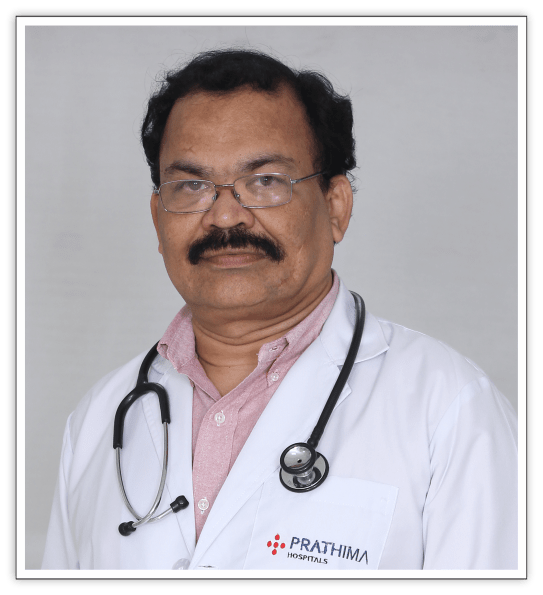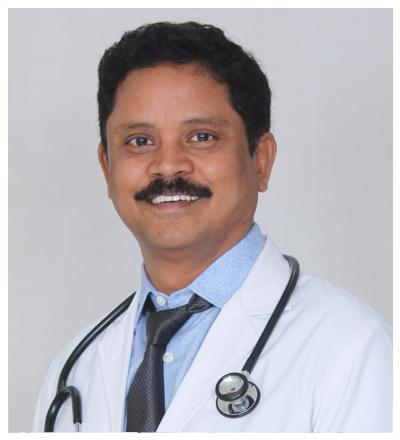 Department of General and Laparoscopic Surgery
Department of General and Laparoscopic Surgery
General and Laparoscopic Surgeries in Hyderabad
General and Laparoscopic Surgery in Hyderabad
The general and Laparoscopic surgery department at Prathima Hospitals focuses on procedures related to the endocrine system, gastrointestinal tract, liver, colon, and other major parts of the human body. Some of the procedures also include an appendix, gallbladder removal, colonoscopies, thyroidectomies, hernia and bariatric surgeries in Hyderabad.
The department treats patients suffering from diseases involving the skin, soft tissue, hernia, and trauma. The general surgery department at Prathima Hospitals provides Tkr Surgery in Hyderabad, and other cutting-edge surgical care to treat its patients. The department also specializes in laparoscopic surgery (also known as key-hole surgery or minimally invasive surgery).
MIS is the well-defined technique of carrying out a surgical procedure through sub-centimeter incisions with minimal collateral tissue injury. The term “laparoscopic surgery” is defined as the minimally invasive access method for certain abdominal wall procedures (like hernia) and for other procedures within the abdominal cavity (like stomach surgery, colon, etc). A “general surgeon” is the generic description for the type of surgeon who practices within this division. General surgeons are considered to be akin to the primary care provider amongst surgeons. The general surgeon is also the backbone of the training curriculum within any general surgery residency.
Our team of surgeons are successfully competent in diagnosis as well as in treating and managing all surgical operative interventions. Our skilled surgeons are trained in various specialties and we have specialized expertise in various disciplines in surgery with team of highly skilled surgeons are trained nurses and technicians.
State-of-the-art operation theatres
- Our hospitals equipped with the latest technologies
- Intra Operative X-beams with C Arm X-beam Machines
- Intra Operative Luminal Endoscopies, LASERS
- Ultrasonic Scalpel
- Laparoscopic operations imported gear from Germany (STORZ) featured with advanced technology.
Minimally invasive surgery
PRATHIMA hospital’s now rendering our services exclusive in minimally invasive surgery.It is a technique that involves fewer incisions and less blood loss, with faster recovery time and moreover it is a day-care process.
Under minimally invasive surgery our services are:
Laparoscopy:
Laparoscopy, also known as keyhole surgery or minimally invasive surgery, is a surgical technique that uses a laparoscope, a thin tube with a camera and light source attached to it, to visualize the inside of the abdomen or pelvis. Laparoscopic surgery requires only a few small incisions, which are used to insert the laparoscope and other specialized instruments to perform the surgery.
Laparoscopy is used to diagnose and treat a variety of conditions, including appendicitis, gallbladder disease, endometriosis, hernias, and certain cancers. Common laparoscopic procedures include cholecystectomy (gallbladder removal), hysterectomy (removal of the uterus), and hernia repair. For more information on Hernia Surgery in Hyderabad, visit Prathima Hospitals.
Endoscopy:
Endoscopy is a non-surgical procedure that uses a flexible tube with a light and camera at the end to examine the inside of the digestive tract, including the oesophagus, stomach, and small and large intestines. Endoscopy is typically performed under sedation or anaesthesia, and the endoscope is inserted through the mouth or anus, depending on which part of the digestive tract is being examined.
Endoscopy is used to diagnose and treat a variety of conditions, including ulcers, polyps, tumors, bleeding, and inflammation. Common endoscopic procedures include upper endoscopy (also known as gastroscopy), colonoscopy, and sigmoidoscopy.
Arthroscopy:
The purpose of arthroscopy is to visualize, diagnose, and treat problems inside joints, such as the knee, shoulder, or hip. During arthroscopy, a small incision is made near the joint, and a small camera and specialized instruments are inserted to view and treat the joint.
Arthroscopy is used to diagnose and treat a variety of joint conditions, including torn ligaments, cartilage damage, and arthritis. Common arthroscopic procedures include knee arthroscopy, shoulder arthroscopy, and hip arthroscopy to perform Knee Replacement Surgery in Hyderabad, visit Prathima Hospitals.
Bronchoscopy:
Bronchoscopy is a minimally invasive procedure used to examine the inside of the airways, including the trachea and bronchi. During bronchoscopy, a flexible tube with a camera and light source at the end is inserted through the mouth or nose and passed down into the lungs.
Bronchoscopy is used to diagnose and treat a variety of lung conditions, including lung cancer, pneumonia, and tuberculosis. Common bronchoscopic procedures include biopsy (removal of tissue for examination), lavage (washing out the lungs), and removal of foreign objects from the airways.
Cystoscopy:
Cystoscopy is a minimally invasive procedure used to examine the inside of the bladder and urethra. Cystoscopy involves inserting a small tube with a camera and light source into the bladder through the urethra.
Cystoscopy is used to diagnose and treat a variety of bladder and urinary tract conditions, including bladder cancer, urinary tract infections, and urinary incontinence. Common cystoscopic procedures include biopsy (removal of tissue for examination) and removal of bladder stones.
Gastroscopy:
Gastroscopy, also known as upper endoscopy, is a minimally invasive procedure used to visualize the inside of the upper digestive tract, including the oesophagus, stomach, and duodenum (the first part of the small intestine). During gastroscopy, a flexible tube with a camera and light source at the end is inserted through the mouth and passed down the throat and into the stomach.
Gastroscopy is used to diagnose and treat a variety of digestive conditions, including ulcers, inflammation, and tumours. It is also used to evaluate symptoms such as abdominal pain, nausea, and difficulty swallowing. During the procedure, the doctor may take samples of tissue (biopsy) or remove polyps or other abnormal growths for further examination.
Gastroscopy is typically performed under sedation or anesthesia, and patients are usually able to return home the same day. The procedure itself takes about 15-30 minutes, and patients are instructed to avoid eating or drinking anything for several hours before the procedure to ensure an empty stomach.
Hysteroscopy:
Hysteroscopy is a minimally invasive procedure used to visualize the inside of the uterus. During hysteroscopy, a thin tube with a camera and light source at the end is inserted through the vagina and cervix and passed up into the uterus.
Hysteroscopy is used to diagnose and treat a variety of gynaecological conditions, including abnormal uterine bleeding, uterine fibroids, and polyps. It is also used to evaluate infertility and perform sterilization procedures.
During hysteroscopy, the doctor may take samples of tissue (biopsy) or remove polyps or other abnormal growths for further examination. Hysteroscopy can be performed under local anesthesia, sedation, or general anesthesia, and patients are usually able to return home the same day.
Laryngoscopy:
Laryngoscopy is a minimally invasive procedure used to visualize the inside of the larynx (voice box) and the upper part of the trachea (windpipe). During laryngoscopy, a thin tube with a camera and light source at the end is inserted through the mouth or nose and passed down into the throat.
Laryngoscopy is used to diagnose and treat a variety of conditions affecting the voice box, including vocal cord nodules, polyps, and tumors. It is also used to evaluate swallowing difficulties and to perform procedures such as removing foreign objects from the airway.
During laryngoscopy, the doctor may take samples of tissue (biopsy) or remove polyps or other abnormal growths for further examination. Laryngoscopy can be performed under local anesthesia, sedation, or general anesthesia, and patients are usually able to return home the same day.
Expertise:
The Department of General Surgery is the expertise of
- Minimal Access Surgery
- Bariatric Surgery
- Transplant Surgery
- Tumors
- Gastrointestinal Surgery Including Hepatobiliary
- Pancreas Surgery
- Colon And Rectal Surgery
It also includes a wide range of malignancy surgeries for a mouth, lungs, digestive system, thyroid and different parts of the body
Some common general surgery procedures include:
Appendectomy : An appendectomy is a surgical procedure to remove the appendix, which is a small pouch-like structure attached to the colon. This procedure is typically performed in cases where the appendix has become inflamed and infected, causing pain and other symptoms. The surgery can be done as an open procedure or a laparoscopic procedure.
Breast biopsy : A breast biopsy is a procedure in which a sample of breast tissue is removed for examination under a microscope. This procedure is typically done to evaluate a breast lump or abnormal mammogram finding. The biopsy can be done as a core needle biopsy, which uses a thin needle to remove tissue, or as a surgical biopsy, which involves removing a larger portion of tissue.
Cholecystectomy : A cholecystectomy is a surgical process to extract the gallbladder. This procedure is typically performed in cases where the gallbladder has become inflamed or infected, causing pain and other symptoms. The surgery can be done as an open procedure or a laparoscopic procedure.
Debridement of wound, burn, or infection : Debridement is a procedure to remove dead or infected tissue from a wound, burn, or infection. This procedure helps to promote healing and prevent the spread of infection. Debridement can be done using a variety of techniques, including surgical excision, mechanical debridement, or enzymatic debridement.
Hemorrhoidectomy : A hemorrhoidectomy is a surgical procedure to remove hemorrhoids, which are swollen veins in the anus or lower rectum. This procedure is typically done in cases where hemorrhoids are causing pain, bleeding, or other symptoms. The surgery can be done as an open procedure or a stapled procedure.
Inguinal hernia repair : An inguinal hernia repair is a surgical procedure to repair a hernia in the groin area. This procedure is typically done in cases where tissue or organs protrude through a weakened abdominal wall, causing pain and other symptoms. The surgery can be done as an open procedure or a laparoscopic procedure.
Mastectomy : A mastectomy is a surgical process to clear one or both breasts. This procedure is typically done in cases of breast cancer or other conditions that affect the breast. The surgery can be done as a total mastectomy, which removes the entire breast, or as a partial mastectomy, which removes only a portion of the breast.
Partial colectomy :A partial colectomy is a surgical procedure to remove a portion of the colon. This procedure is typically done in cases of colon cancer, inflammatory bowel disease, or other conditions that affect the colon. The surgery can be done as an open procedure or a laparoscopic procedure.
Prostatectomy : A prostatectomy is a surgical technique to dismiss the prostate gland. This procedure is typically done in cases of prostate cancer or other conditions that affect the prostate. The surgery can be done as an open procedure or a laparoscopic procedure. There are several types of prostatectomy, including radical prostatectomy, which removes the entire prostate gland, and transurethral resection of the prostate (TURP), which removes only a portion of the prostate gland.
We PRATHIMA hospitals keep a record of continuous evolution in general and a surgical specialty challenges us to stay the best in the Hyderabad for a center of excellence, recognized by the patients and the medical fraternity.
Total Knee Replacement Surgery Doctors in Hyderabad






